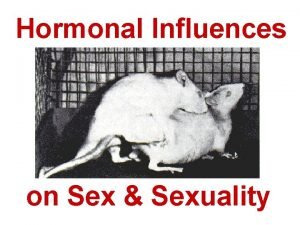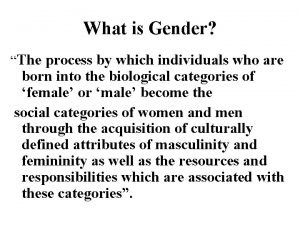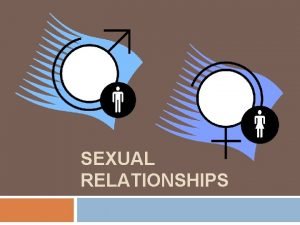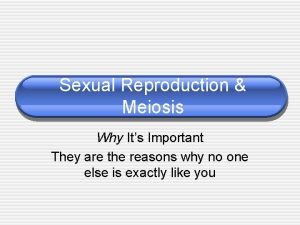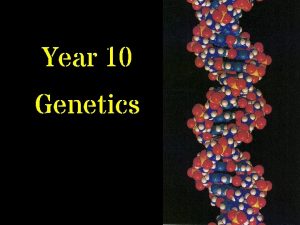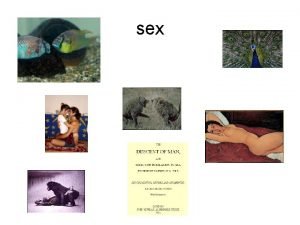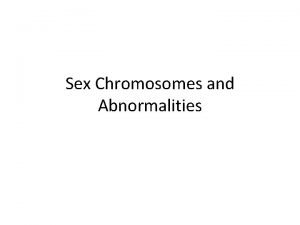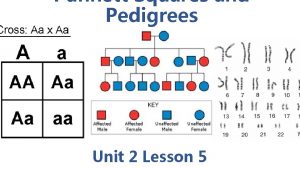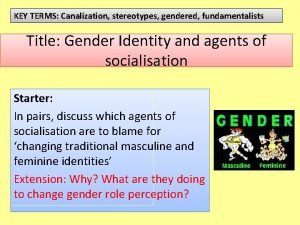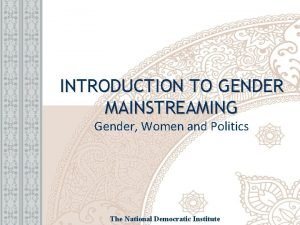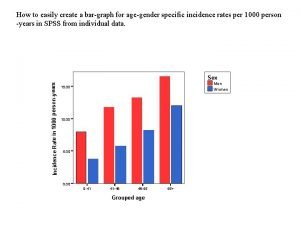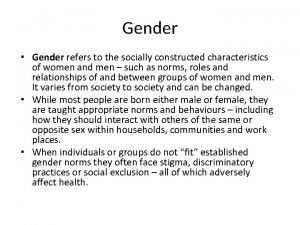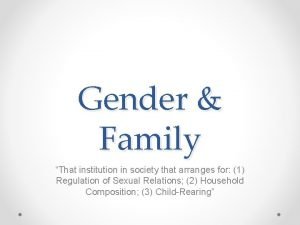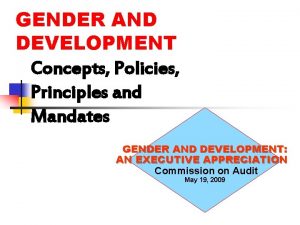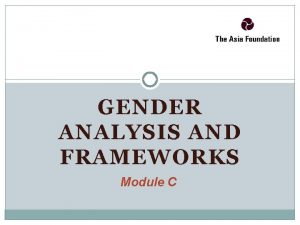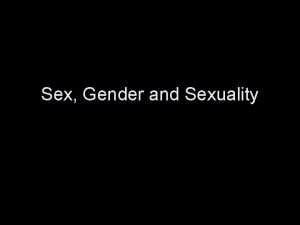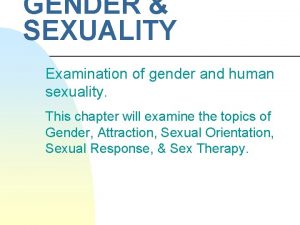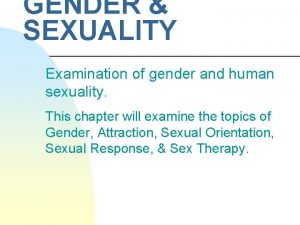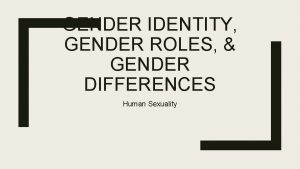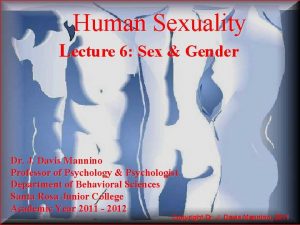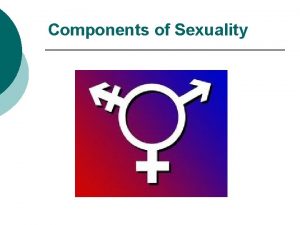Human Sexuality Lecture 6 Sex Gender Dr J


































![What this astounding statistical finding suggests is that normal healthy individuals [blue control group] What this astounding statistical finding suggests is that normal healthy individuals [blue control group]](https://slidetodoc.com/presentation_image_h/1a0339b9b89c40d53f5d951520204ffa/image-35.jpg)











































- Slides: 78

Human Sexuality Lecture 6: Sex & Gender Dr. J. Davis Mannino Professor of Psychology & Psychologist Department of Behavioral Sciences Santa Rosa Junior College Academic Year 2011 - 2012 Copyright Dr. J. Davis Mannino, 2011

Human Sexuality Lecture 6: Sex & Gender Dr. J. Davis Mannino Professor of Psychology & Psychologist Department of Behavioral Sciences Santa Rosa Junior College Academic Year 2011 - 2012 Copyright Dr. J. Davis Mannino, 2011

Reminder - First Exam is Thursday, September 29 th - Chapters 3, 4, & 6 in Textbook and Chapters 1, 2, 3, 4, & 16 in Workbook - Exam is Open Book - Complete the Two Workbook Exercise pp. 32 -35. 1. Remember the workbook exercise is worth 20% of the exam grade. 2. Read each exercise and complete anything asked of you in the exercise. 3. Typed Reaction Paper. A reaction paper is a summary of what you learned, experienced, felt, learned, etc. , from having completed the two exercises. 4. Tear out at least one of the original pages from workbook and staple page and reaction paper together. Reaction paper should be on top 5. Make sure name, class name and section number are clearly written on front.

Gender and Sexuality n Who should use a women’s bathroom n A person with a penis, wearing a dress? (TV, TS, TG) n A person with a penis, uterus, and ovaries wearing a dress? (Intersexed) n A mother with her son, age 4? n A father with his daughter, age 18? What are the differences between men and women? Where do these differences come from?

Sugar and Spice and Everything Nice n Sex – biological n Gender – social identity n Gender roles – the culturally defined behaviors associated with gender n Sexual Orientation – attraction n The “Nature vs Nurture” debate continues into sex and gender. Where do little boys and girls come form? “Sugar and Spice and Everything Nice? ”

We Have Come A Long Way in our understanding of sexual gender since 355 BC. In those days, Aristotle suggested that the difference between the two sexes was due to the heat of semen at the time of intercourse. Hot semen generated males, whereas cold semen made females. Thankfully, we now know a little more about the molecular events of sex determination. Usually, a woman has two X chromosomes (XX) and a man one X and one Y (XY). However, both male and female characteristics can sometimes be found in one individual. It is possible to have XY women and XX men. Analysis of such individuals has revealed some of the molecules involved in sex determination, including one called SRY, which is important for testis formation. SRY is short for Sex-determining Region Y gene. It is found on the male Y chromosome. gene

What generally is the first thing people ask when they hear of a newborn arrival? Not how healthy the baby is, but rather is it a boy or is it a girl! ---usually in that order, too



Things Going Wrong or Nature Varying? At about the sixth week, in male embryos, Mullerian Inhibiting Factor (MIF) prevents development towards a uterus, womb Factor (MIF) and ovaries. At the same time androgens, male steroid horandrogens mones, are produced, as the testes begin to form. There are several X-linked (or sex-linked) recessive genetic disorders, (hemophilia, muscular dystrophy) which are inherited through a genetic defect on an X chromosome. A female has 2 X chromosomes, one she inherited from her mother and one she got from her father. A male has an X chromosome from his mother and a Y chromosome from his father. Females may get the defective gene either from her mother's defective X, or, if her father has the disorder, from her father. In either case, the girl will be a carrier and will probably pass the defect to her offspring. She will not manifest the disorder the way a boy would, because she has 2 X chromosomes, and the dominant X will compensate for the defect on the recessive X. Only if a female has 2 parents with the defect on their X chromosomes will she get a milder form of the disorder.

Androgen Insensitivity Syndrome XY males with this genetic defect produce plenty of androgen hormones but lack androgen receptors and thus their tissues cannot respond to the male hormones. The result is testicular feminization

Up until about the eighth week of embryo development, it is the gonads that are developing as a result of either the presence or absence of SRY expression. The external genitalia grow identically for either sex. The next step in development of “maleness is expression of an enzyme, 5 alpha reductase, produced in males, which conreductase verts testosterone to dihydrotestosterone The result is that the baby may be labeled as a girl at birth. But, at puberty the rise of testosterone allows development to finally proceed towards its assigned completion. Gender differs greatly, so much so, we must consider the concept “transgender!”

Four siblings with testicular feminization syndrome. All four subjects in this photograph have 44 autosomes plus an X and a Y. That makes them all genotypically males, but because they have inherited the recessive sex-linked allele conferring insensitivity to androgens (male hormones), they “look” like females. http: //www. cbs. dtu. dk/dave/roanoke/bio 101 ch 15. htm

Sex and Gender n Sociologists argue that a large component of gender is learned. Ø How do we know? Ø Margaret Mead’s studies in New Guinea Ø Pinks and Blues study in infancy* Ø Gender socialization prac- tices and expectations vary around the world and over time “Modeling” is part of “Social Learning Theory”

n Differential reinforcement refers to encouraging sexappropriate play and discouraging cross-sex play. n Parental expectations - self-fulfilling prophecies Role Appropriate Behavior

Pink & Blues Study n In a classic study three groups played with an infant. One group was told the infant was male, the other female, and the third group was NOT told what gender the baby was. n The group who thought the infant was male observed all types of masculine traits, like strong feet and angry “bull-headed” cries, while the group that thought they held a female observed gentle qualities associated with femininity such as “soft, ” and cries that were those of a “frustrated” baby girl. More interesting was the third group who displayed noticeable discomfort in not knowing the infant’s gender. But in time, simply based on the infant’s behaviors, they labeled the infant a boy. Once the gender label had been attached, the group began to ease up and see masculine traits even though they were wrong about the gender, as were others when the study was replicated many times (Condry & Condry, 1976).

Gender and Culture n Many cultures have different concepts of sex and gender than that of the West. Ø Some have more than two sexes. – Navajo Nadle Ø Some have more than two genders – Chuckee from Siberia – 6 genders, Zuni – three genders, Hijira in India, etc. Ø Gender roles also vary widely the Human Area relations files notes that women are often the expected home builders, fuel gatherers, and carriers of heavy objects, whereas men are often the garment makers and cleaners. Plains Indian Woman Hunting Buffalo, cira 1837

Gender and Culture n “The fantasy is different for each dreamer. ” n But, as the ancient Greek plate below depicts, the man-woman theme is as old as time and as natural as sexuality itself. At the core of each fantasy is the desire to cross the great gender divide. If only for a short while. And then, to cross back over without worry or harm. Terracotta Earthen Plate, Greek, 2000 BCE

Gender Socialization n How do we socialize girls and boys differently in our society? Ø Toys Ø Games Ø Education Ø Family Roles Ø Dress One of the charges levied against Joan of Arc, was that she dressed as a man -- she was burned at the stake by the Catholic Church Joan of Arc

Why do Gender Roles Exist? n Functionalists – Gender roles are functional for societies, however they vary according to patterns of subsistence. Gender roles may be related to interpretations of biological differences. n Conflict Theorists – Gender roles are exploitative of one gender over the other – usually women – This reflects larger economic differences in power in a society. n Symbolic Interactionists – Gender roles are learned and internalized and gender role socialization begins the day we are born. In essence, “constructed. ”

Gender and Reproductive Behavior Understanding gender provides: v insights into men’s and women’s behavior v Relationships v Reproductive decisions v These insights are crucial to communicating with and serving both men and women effectively.

Gender and Reproductive Behavior v “Gender” refers to the different roles that men and women play in society. v To rights and responsibilities that come with these roles. v “Gender” differs from “sex”, which refers to the biological and physical differences between men and women.

Gender and Reproductive Behavior Gender - usually taken for granted but reflected in: v. The influence of gender is similar in strength to religion, race, social status and wealth. v. Family Structures v. Household responsibilities v. Labor markets v. Schools v. Health care systems v. Laws v. Public policies

Equal But Different

Santa, Gender, and Kids! n So powerful is our socialization in childhood to act male or female and display either feminine or masculine traits according to our biological sex, that even letters to Santa Claus are “gender appropriate!” For example, one famous study examined 750 children’s letters sent to Santa Claus care of a local post office. Kids if left on their own, will regulate gender expression and socialize according to society’s wishes

Santa, Gender, and Kids! n The letters clearly showed that boys and girls knew which toys were considered correct for them. Boys asked for guns and racecars and girls asked for dolls and arts-and-crafts toys. This research clearly shows that when children are left to their own devices, they prefer toys and games consistent with their own gender. Many of the toys and games asked for could not be traced to either parental guidance or media, thus adding credence to the saying, “Boys will be boys, and girls will be girls. ” n It is interesting to note that among children who did ask for the “other gender’s” toys, it was girls who were more likely to ask for them (Richardson & Simp- son, 1982). Maybe this is a tribute to the human spirit to be true to oneself, even when it runs against the grain of what society calls gender appropriateness.

Santa, Gender, and Kids! n A more recent study of letters to Santa Claus found positive changes, however. Girls were as likely as boys to ask for “action-oriented” bicycles and sporting toys, and boys were as likely as girls to ask for arts-and-crafts “activity-oriented” toys (Freeman et al. , 1995). Dressed to Govern Edward Hyde (16611723) was governor of both the New York and New Jersey British colonies from 1702 to 1708. Here in this picture he poses in fine women’s clothing for his official portrait! Perhaps gender seems more blurred today than in the past, but it has had wide variation throughout history too

Gender and Learned Helplessness n Gender roles are learned and internalized early on in life. n Gender role socialization begins the moment we are born. More than just Genes and Chromosomes. . .

What I have Learned: Is the glass half full or half empty? : Optimism vs. Pessimism n Adversity effects us all. But for some, adversity leads to a belief that the future holds nothing but adversity. In time, such people learn to become helpless, depressed, and further hopelessness emerges. § What forty years in counseling & education has taught Dr. Mannino about life. § No one is smart enough, knowledgeable enough, or old enough to be a pessimist!

Learned Helplessness But when uncontrollable events persist, we may begin Some events are to believe such uncontrollable, like despair will never end. the “dust bowl” despair days of the In such cases, some “Great Depression, 9 victims no longer try 11, and Katrina” to even “escape” their despair, even when We must ride them tools to escape are out! available to them!

Learned Helplessness • What is “learned helplessness? ” • Examples? • Martin Seligman in 1976 • Research findings • Helplessness and Depression • Is it truly learned? • Cure is to learn how to be optimistic • In a “nutshell” • Book: “Learned Optimism” Psychology is much larger than curing mental illness or curing diseases. I think it’s about bringing out the best in people; it’s about positive institutions; it’s about strength of character.

Learning Helplessness Martin Seligman is responsible for The Learned Helplessness (LH) model of depression which had a major influence on psychological research into depression in the 1970 s. Seligman discovered LH by accident will studying the effects of inescapable shock on active avoidance learning in dogs. Dogs were restrained in a Pavlovian harness and administered several shocks (UCS) paired with a conditioned stimulus (CS) - this is the conventional CS-UCS pairing procedure used to study classical conditioning. Then these dogs were placed in a shuttle-box where they could avoid shock by jumping over a barrier. The shuttle-box was used to study the role of operant conditioning in learning. Most of the dogs failed to learn to avoid shock. Seligman argued that prior exposure to inescapable shock interfered with the ability to learn in a situation where avoidance or escape was possible. Seligman used the term Learned Helplessness (LH) to describe this phenomenon.


![What this astounding statistical finding suggests is that normal healthy individuals blue control group What this astounding statistical finding suggests is that normal healthy individuals [blue control group]](https://slidetodoc.com/presentation_image_h/1a0339b9b89c40d53f5d951520204ffa/image-35.jpg)
What this astounding statistical finding suggests is that normal healthy individuals [blue control group] have learned to be clever in avoiding and moving in and out of hostile environmental situations. But those who found themselves in hostile environments early on, [red experimental group] --- where no matter how they tried --- could not change or avoid their hostile environments, soon learned that ALL hostile environmental situations are neither changeable or avoidable. We call this “Learned Helplessness”

How Helpless Are You? You will be assigned either group A or group B to work on. Unscramble each of the anagrams in each group as directed. An anagram is a word or phrase made by transposing the letters of another word or phrase Be sure to work on only that group assigned to you. Work as fast as you can, proceeding in order from the first anagram to the last. Group A Group B --------------------------------------------------------------------------- LAIN YAKE SRUH ITNC EDHA HOLO ERAL FELM OBOK CORL DOLS

How Helpless Are You? You will be assigned either group A or group B to work on. Unscramble each of the anagrams in each group as directed. An anagram is a word or phrase made by transposing the letters of another word or phrase Be sure to work on only that group assigned to you. Work as fast as you can, proceeding in order from the first anagram to the last. ANSWERS Group A Group B --------------------------------------------------------------------------- NAIL YAKE RUSH ITNC HEAD HOLO REAL FELM BOOK CORL SOLD


“Rejection, failure, death of a loved one--human loss in general--sometimes teaches people to be helpless, depressed, and pessimistic. If helplessness is learned, then the antidote to helpless-ness--an optimistic pattern in thinking and action--might also be learnable. After all, life inflicts the same setbacks and tragedies in the optimist as on the pessimist. ” - Martin Seligman, 1991 The pessimist says the cup is half empty; the optimist says the cup is half-full; and the advertising man says, "Get a bucket, that cup is overflowing!" In Learned Optimism, Dr. Martin Seligman takes a full look at optimism and pessimism.

Happiness is. . . … What happiness does. This video clips asserts that we are happy when we smile, think and act happy. In essence, if we think happy [cognitive restructuring], visualize happy [visualization], and act happy [behavior modification] we truly can all become happy. So act happy. . . . and you’ll be happy

Symptoms of Depression 1. depressed mood 2. lack of interest in, and pleasure from, almost all activities 3. decreased appetite leading to weight loss 4. insomnia or hypersomnia 5. psychomotor agitation or retardation 6. feeling without energy 7. feelings of worthlessness and guilt 8. inability to think clearly or concentrate effectively, indecisiveness 9. thoughts of death, suicidal thoughts Corresponding Symptom in Learned Helplessness 1. helplessness 2. cognitive representation of uncontrollability 3. helpless animals eat less & loose weight 4. I know of no study on this point 5. helpless animals are passive in face of shock 6. lack of response initiation 7. perception that individual cannot control their environment 8. cognitive representation of uncontrollability 9. helpless animals may die in traumatic situations

So act happy. . . . and you’ll be happy The research is clear!

Human Sexuality Lecture 6 - Sex & Gender Consider how gender shapes how and who you are? The End Thursday: Video “Is it a boy or is it a girl? Following Week: Love & Attraction Joan of Arc

Gender and Violence Albert Bandura's Bobo Doll Experiment n Not all learning occurs through first-hand experience. In observational learning, we learn by observing and imitating another person's (a model's) behavior. n Children learn many types of social behavior, both prosocial and antisocial, by observing and imitating models. They imitate what a model does and says. n Albert Bandura was the first to conduct controlled experiments on observational learning in children. n Albert Bandura narrates this video of one his most famous experiments in observational learning. An adult models for a child both aggressive behavior and aggressive language.

Gender and Violence Albert Bandura's Bobo Doll Experiment

Gender and Violence Questions to Consider Summarize how Bandura set up his experiment. 1. What role did the control group play in the experiment? What difference in behavior was noted between the control group and the experimental group? 2. Discuss what this experiment tells us about the possible "cathartic" role of watching people act aggressively. 3. What does the experiment suggest about the effects of violent films and TV shows on children? What factors might affect whether a child imitates aggressive behavior that he or she sees on TV?

Human Sexuality Lecture 6: Sex & Gender Dr. J. Davis Mannino Professor of Psychology & Psychologist Department of Behavioral Sciences Santa Rosa Junior College Academic Year 2011 - 2012 Copyright Dr. J. Davis Mannino, 2011

Human Sexuality Lecture 6: Sex & Gender Dr. J. Davis Mannino Professor of Psychology & Psychologist Department of Behavioral Sciences Santa Rosa Junior College Academic Year 2011 - 2012 Copyright Dr. J. Davis Mannino, 2011

Transsexual Teacher Video Clip These Women Were Once Men

Transsexualism “A Close Facsimile” In 1998, the world’s first hand transplant occurred. So too, an Italian plastic surgeon asked permission from authorities to perform the world’s first penis transplant. He suggested “twinning” sex change patients (Pullella, 1998), that is, using the penis from a male-to-female patient on a female-to-male patient. Surgeons are fast becoming auto mechanics. Exchange a part, find a part, install a part. Engendering sex is less the problem these days; it is creating the spirit of gender that is tougher. Building acceptance in others--that has become the mighty task (Author’s lecture notes).

Being Number One! Ladies and gentlemen, thank you for coming, but I think this is really too much!” Such were the words of Christine Jorgensen as she stepped off a plane from Denmark on February 13, 1953, besieged by the largest gathering of news reporters in the history of New York International Airport (Benjamin, 1966). What was so special about Ms. Jorgensen? First, she was an American GI born George Jorgensen, a man who served in World War II. Secondly, in the eyes of the world she was the first transsexual to have sexual reassignment surgery (SRS), a radical surgical procedure for changing one’s external sexual anatomy to appear as the other gender (Hamburger, 1953). * Third, her courageous ground-breaking initiative introduced transsexualism to the world. In describing her transition from male-to-female and all the suffering, notoriety, and loss of privacy that came with that decision, Christine Jorgensen wrote in the last paragraph of her autobiography, “I have found the gift of heaven—to be myself” (Jorgensen, 1968).

Definitions of Transsexualism n There is general agreement that transsexualism occurs when a person strongly believes that they belong to the opposite sex. n This is typically a lifelong feeling and results in varied degrees of physical/external changes n There is also some debate around what transsexualism should be named. The illustration above appeared on the cover of Supplement 154 of the Scandinavian Journal of Urology and Nephrology (1993). This supplement was entirely devoted to Sven-Olaf Rubin's discussion of his technique of sexual reassignment surgery. Although Rubin's article is an important one, its cover illustration was not widely known or seen

Different Names Just a: n “Condition” n “Phenomenon” n “Mental Disorder” n “Neuroendocrine Disorder” n “Gender Identity Disorder (GID)” n “Pathological disorder” Right: Photo of the details of the genitalia of a TS woman (with her legs spread in stirrups and her labia partially opened) after having SRS and labiaplasty performed by Eugene Schrang, MD of Neenah, WI.

“Transsexual” vs. “Transgendered” n Transsexuals Ø people who have had partial or total sex-change surgery or who take hormones in order to change their physical appearance n Transgendered Ø people who live as the opposite sex without any alterations of their physical appearance through hormones or sex-change surgery

Myths about Transsexualism n A transsexual is a male homosexual Ø Transsexualism is not a matter of homosexuality but rather one of gender identification n A transsexual is a transvestite Ø A transvestite typically only dresses similar to the opposite sex to fulfill a fetish but still remains “true” to their original gender identity n A transsexual is “created” by cutting of the penis and replacing it with a constructed vagina Ø Typically, the only parts that are removed are the testes and the inner tissue of the penis. ALL of the other tissue is used to construct female genitalia.

Historical Background n Transsexualism was not recognized in the medical field until 1853. n 1949 - termed “psychopathia transsexualis” by Cauldwell n 1966 - Harry Benjamin published The Transsexual Phenomenon deemed it incurable Ø only treatment - sex reassignment surgery Ø his patients were among the his most miserable Ø n 1980 - DSM first defined transsexualism as an illness

Diagnosis (DSM-IV-R) n A strong and persistent cross-gender identification n Persistent discomfort with their assigned natal sex and its associated gender role n Absence of any physical intersex condition n Clinically significant distress or impairment of social or occupational functioning. ” Transsexual Expert and Pioneer Dr. Harry Benjamin, MD

Differential Diagnosis n Transvestic Fetishism n GID NOS (i. e. : gender identity with concurrent congenital intersex condition) n Psychotic Disorders n Manic Episode n Paraphilias n Normal Experimentation Artist Comment: This is how it feels to be a transsexual……

DSM IV - GID n A. Strong and persistent x-gender ID (not for perceived cultural advantages of being other sex) Ø In Children – 4 or More: n Repeated stated desire to be, or insistence of being other sex n In boys, preference for x-dressing or simulating female attire; in girls, insistence on wearing only male clothing n Strong and persistent preferences for cross-sex roles in make believe play or persistent fantasies of being the other sex n Intense desire to participate in the stereotypical games or pastimes of the other sex n Strong preference for playmates of the other sex

DSM IV - GID n A. In Adolescents and Adults Ø Stated desire to be the other sex Ø Frequent passing as the other sex Ø Desire to live or be treated as the other sex Ø Conviction that he or she has the typical feelings and reactions of the other sex

n B. Persistent discomfort with his or her sex or sense of inappropriateness in the gender role of that sex. Ø In Girls: n Rejection of urinating in sitting position n Assertion that she will grow a penis n Assertion that she does not want to grow breasts or menstruate n Marked aversion toward normative feminine clothing Ø In Boys: n Assertion that his penis or testes are disgusting or will disappear or that it would be better to not have a penis n Aversion toward rough and tumble play n Rejection of male stereotypical toys, games, activities

Management and Treatment n Full Life Experience n HB Standards of Care Ø Internist Ø Psychiatrist (mental health) Ø Endocrinologist Ø Urologist Ø Surgeon Welcome to the Transgender Law and Policy Institute. We are a non-profit organization dedicated to engaging in effective advocacy for transgender people in our society. The TLPI brings experts and advocates together to work on law and policy initiatives designed to advance transgender equality.

Prevalence n Not common and exact prevalence is unclear n Estimations Ø one in 700 people affected Ø 10 times more common in men Ø. 025% of American population call themselves transsexual Ø vast majority are in the West Ø occurs in both heterosexual and homosexual individuals

Etiology n Much debate as to the cause of transsexualism n Ellis - sex assignment and rearing responsible n Money, Hampson, and Hampson - socialization rather than birth is responsible n Stoller - found little evidence of genetic causes

Treatment n Purpose is to help patients achieve their goal rather than attempt to change their identity n A common treatment is called Sex Reassignment Surgery (SRS) however, there are guidelines that are to be followed if this is the route to pursue. Female to Male “pre-op” Transsexual.

Guidelines for SRS n The patient must first undergo the Real Life Test (RLT). n The patient lives and works as the “new” sex for a year in order to learn how to survive. n The patient also begins to take hormones to alter body chemistry. Male transsexual after hormone treatment and conversion operation.

Sex Reassignment Surgery n The procedure itself takes between four and five hours. n The health, fitness, hygiene, and age of the patient are key factors in the success of the surgery. n There are different procedures involved in the surgery depending on whether a male is reassigning to female or a female is reassigning to male.

For Male to Female Transsexuals n n n n Vaginoplasty (construction of a vagina) Penectomy (removal of the penis) Orchidectomy (removal of the testes) Clitoroplasty (construction of a clitoris) Breast augmentation (breast enlargement) Rhinoplasty (reshaping the nose) Hair transplants and face remodeling

For Female to Male Transsexuals n n hysterectomy (removal of the uterus) oophorectomy (removal of the ovaries) bilateral mastectomy (removal of the breasts) phalloplasty (construction of a penis)

Hormone Treatment Method n Hormones are manufactured and controlled by the endocrine system n They are chemical messengers to the body n “Artificial” hormones may be given to patients to produce desired effects n Sometime there also a few undesired effects. n The hormones have different effects for different patients

Male to Female Hormone Effects n n n Fertility decreases Male sex drive decreases Breast size increases Fat is redistributed Body hair growth decreases Muscle tone may decrease Oil and sweat glands become less active Metabolism decreases Fingernails become brittle Body odors change Female sex drive increases

Female to Male Hormone Effects n n n Vocal cords thicken Fertility decreases Clitoris elongates Body and facial hair increase Male pattern baldness may set in Oil and sweat glands may set in

Social Issues n With any change in physical appearance, whether by SRS or hormones, there are bound to be social issues that arise. n For example Ø the need for a support group Ø facing employment discrimination Ø facing rejection from family and friends Ø beginning new relationships in the community Ø attempting to live a fulfilling life

Ethical Issues n With any medical proceedings, there are ethical considerations n There are three main duties of the psychologist that they are required to fulfill Ø identify clearly the client and their rights Ø never cause any harm to the client whether actively or passively Ø show sensible regard for moral and legal standards

Gender Identity Disorder (GID)Part 1

Gender Identity Disorder (GID) Part 2

Gender Identity Disorder (GID)Part 3

Human Sexuality Lecture 6 - Sex & Gender Consider how gender shapes how and who you are? The End Next Week: Love and Attraction This Thursday Exam #1! Joan of Arc
 Chapter 10 sex gender and sexuality
Chapter 10 sex gender and sexuality Sex gender and sexuality
Sex gender and sexuality Difference between sex and gender
Difference between sex and gender Sex sex sex
Sex sex sex Snv sex
Snv sex Sex sex sex
Sex sex sex Sex sex sex
Sex sex sex Sex sex sex
Sex sex sex Strategic gender needs and practical gender needs
Strategic gender needs and practical gender needs Sex vs gender essay video
Sex vs gender essay video Gender and sex difference
Gender and sex difference Difference between sex and gender
Difference between sex and gender Difference between sex and gender
Difference between sex and gender Y chromosome traits
Y chromosome traits Sex determination and sex linkage
Sex determination and sex linkage Sex determination and sex linkage
Sex determination and sex linkage Once a sex offender always a sex offender
Once a sex offender always a sex offender 01:640:244 lecture notes - lecture 15: plat, idah, farad
01:640:244 lecture notes - lecture 15: plat, idah, farad Sexuality in advertising
Sexuality in advertising Four intertwining strands of sexuality
Four intertwining strands of sexuality Pretest growth development and sexuality
Pretest growth development and sexuality Awareness, acceptance and comfort with one’s own body.
Awareness, acceptance and comfort with one’s own body. Definition of sexuality
Definition of sexuality Types of sexual relationships
Types of sexual relationships Which illustrates an emotional aspect of teen sexuality?
Which illustrates an emotional aspect of teen sexuality? Peer sexuality support programme
Peer sexuality support programme Base of uterus
Base of uterus Sexuality spectrum
Sexuality spectrum Dependency ratio geography
Dependency ratio geography How many chromosomes are in a human’s sex cells?
How many chromosomes are in a human’s sex cells? Management fifteenth edition
Management fifteenth edition Human resources introduction
Human resources introduction Human resource management lecture chapter 1
Human resource management lecture chapter 1 Human vs non human bones
Human vs non human bones Chapter 8 human needs and human development
Chapter 8 human needs and human development Chapter 8 human needs and human development
Chapter 8 human needs and human development Gni definition ap human geography
Gni definition ap human geography Non human nouns
Non human nouns Female karyotype
Female karyotype Xxy gender
Xxy gender Gender action plan world bank
Gender action plan world bank Gender action plan world bank
Gender action plan world bank Wad approach to development
Wad approach to development Define gender parity
Define gender parity Language and gender
Language and gender Slidetodoc.com
Slidetodoc.com Define gender constancy
Define gender constancy Gender socialization is a lifelong process.
Gender socialization is a lifelong process. Doing gender definition
Doing gender definition Snow white and the seven dwarfs gender roles
Snow white and the seven dwarfs gender roles Xxy chromosome gender
Xxy chromosome gender Explain sex determination
Explain sex determination Gender-neutral housing pros and cons
Gender-neutral housing pros and cons Moser framework tools
Moser framework tools Is there any bias in gender roles based on the excerpt
Is there any bias in gender roles based on the excerpt Pedigree
Pedigree Paradigm shift from women studies to gender studies
Paradigm shift from women studies to gender studies Mbti by gender
Mbti by gender Canalization gender
Canalization gender Judith butler performative acts and gender constitution
Judith butler performative acts and gender constitution Gender criticism definition
Gender criticism definition Feminist criticism in the story of an hour
Feminist criticism in the story of an hour What is gender mainstreaming?
What is gender mainstreaming? Gender interpersonal communication
Gender interpersonal communication Gender en diversiteit schakelprogramma
Gender en diversiteit schakelprogramma Gender graph
Gender graph Gender roles and identity
Gender roles and identity Gender responsive pedagogy
Gender responsive pedagogy What is gender mainstreaming?
What is gender mainstreaming? Stefan vater
Stefan vater Gender refers to
Gender refers to Doing gender
Doing gender Pai dan gender
Pai dan gender Koenraad kuiper gender theory
Koenraad kuiper gender theory Gender and development principles
Gender and development principles Parts of gender analysis framework
Parts of gender analysis framework Gender social stratification
Gender social stratification Feminist literary criticism
Feminist literary criticism Sex of fetal pig
Sex of fetal pig

